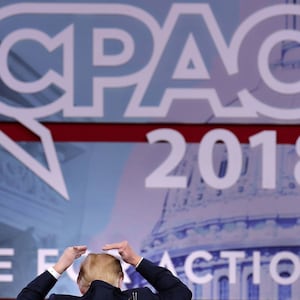Wednesday morning, the biggest event for young conservatives in the country, the Conservative Political Action Conference, will begin in suburban Maryland, running through Saturday. For years it’s been touted as the event that predicts the future of conservatism even as it highlights current issues.
But it has struggled in the Trump era. Whereas CPAC used to be a platform for a party of ideas, propagated by conservatives’ biggest names, it’s now unsure of itself, especially in the aftermath of last fall’s electoral defeats for the GOP, wavering between the competing values of ideas and entertainment.
To the extent that CPAC is no longer a conference of ideas, it’s because the GOP is no longer a party of ideas. Its leader, the president, juggles both a quasi-conservative agenda and personal grievances with equal weight. So it’s impossible to build a coherent conference agenda around someone who still isn’t sure what it really means to embrace conservative ideals because he isn’t even clear on what they are yet.
ADVERTISEMENT
Still, it’s wildly popular among a certain base. Annually, over 10,000 attendees meet at the Gaylord National Resort for this event, mostly college students. CPAC invites “Conservatives Who Matter”—from politicians and business owners to journalists and radio hosts—to speak to the next generation on a range of topics in a ballroom complete with thumping introduction music.
Through smaller offshoot “breakout sessions,” CPAC aims to inform and fire up attendees up about conservative ideals, compelling them to take on persuasive activist roles. It boasts an homage to every conservatives’ favorite president, in the form of a Ronald Reagan dinner.
But what are we cheering now? While Trump has been strong on some issues—like advocating for life via new HHS policy rules, nominating originalist judges for the federal bench, and harping on national security with the border wall he promised—his reputation as a global leader has suffered. His own administration has been a revolving door of staffers. He tweets impulsively and often, it appears, before clarifying policies and procedures with his own staff. The Russia investigations, which most conservatives believe are a witch hunt of epic proportions, have nevertheless chipped the armor of his appealing alpha male leadership. It’s one thing to take charge; it’s another to be accused of being a pawn in the game of Russia’s global ambition.
Over the years, CPAC has often reflected the party’s current issues and stars. During the Bush years the speakers pushed his agenda and re-litigated the Iraq War. During the Obama election years it was about finding its post-Bush identity. In those days it also became more of a fever swamp (who can forget Sarah Palin drinking from her Big Gulp on stage?) grappling with ways to poke holes in the left’s agenda.
Now, it's Trump's party, but conservatives can’t agree on how they see him. To some, Trump is the antidote to Obama’s “hope and change.” Unlike his predecessors, he forgoes political buzzwords to tell it like it is; he has, to this group, “drained the swamp.” He boasts at least a 50-percent approval rating in 17 states for the aforementioned accomplishments.
To others, he lacks principle (as Stormy Daniels can attest), fails to follow protocol, and wants to govern by tweet. Whereas most presidents gather experts to inform them about foreign and domestic policy, Trump appears to take no one’s advice, since his administration has been a revolving door of resignations and new hires.
Despite his efforts to appeal to the mainstream GOP, he often demonstrates authoritarian impulses, stemming no doubt from his populist thinking. One would like to believe no one on in America wants to revert to that kind of governing. His party’s electoral defeat means he’ll pass no more meaningful legislation, as the defeat of the Born Alive Act can attest.
Of course, conservatism—and what conservatives cheer for at CPAC—is by no means a lost cause. Sure, they “got” Trump—I voted for him too—but his unique personality and decision-making skills have come at a cost. This year’s speakers demonstrate a wrestling match between a nod to an era of conservatism gone by, like Kay Coles James and Rich Lowry, and a new wave of Trump supporters like Kyle Kashuv, Jeanine Pirro, and Diamond and Silk.
This isn’t exactly the party of Reagan. It’s time to decide whether CPAC is a circus for showroom conservatives or a pre-game locker meet where they lay out a game-winning strategy for the future of conservative ideas. Sure the CPAC agenda tackles the left’s talking points, “fake news,” and the Second Amendment—but conservatism is so much more than this.
This is neither Trump’s agenda nor the kind of committed conservatism than can rescue it, but a mediocre middle ground. It’s hard to celebrate a conservative movement that isn’t sure how to grapple with its leader because their leader isn’t sure what conservatism is or how to push that agenda forward.





